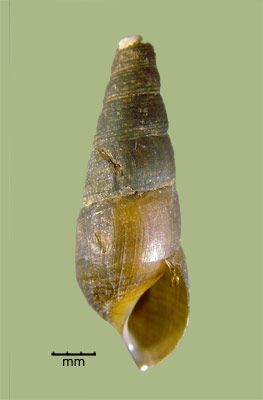Goniobasis or Elimia virginica
> Habitat & Distribution
Populations of P. virginica are widespread in Atlantic coastal drainages, ranging from Connecticut and Massachusetts to North Carolina, and as far west as central New York State (Goodrich 1942, Jokinen 1992, Harman 2000, Stewart and Dillon 2004). The Hudson River population of P. virginica seems to have spread north through the Erie Canal and into the Great Lakes, and we are aware of one population in NW Pennsylvania's Conneaut Lake, in the drainage of The Ohio.
Populations seem to reach maximum abundances in larger rivers, such as the James, the Potomac, and the Susquehanna, but also certainly occur in smaller streams and northern lakes. Rock and other hard substrata are preferred habitat, but individuals can be found on soft substrata and vegetation (Harman 1972, Jokinen 1992). FWGNA incidence rank I-5.
> Ecology & Life History
This and other pleurocerids are grazers of epilithic periphyton (Harman 2000). Where they reach high densities, grazing by pleurocerid populations can have a significant effect on energy flow in streams (Dillon 2000: 86 - 91). Habitat degradation caused declines and local extinctions of stream- and lake-dwelling Pleurocera virginica populations in the northeastern United States during the 20th century (Smith 1980, Harman 2000).
Like other pleurocerids, P. virginica is dioecious, eggs being deposited on hard substrates from spring to mid-summer. Eggs are spirally arranged in masses of 2-15 or more, with a tough, membranous outer covering (Smith 1980, Jokinen 1992). Although we are unaware of any study specifically directed toward the life history of P. virginica, it seems reasonable to expect that two years will be required for maturity, and that several years of iteroparous reproduction can be expected thereafter, as is the case for pleurocerids generally (Dazo 1965). This is life cycle Hi of Dillon (2000: 156 - 162).
The histopathological effect of trematode infection
in a New Jersey population of P.
virginica was described by Huffman & Fried (1985).
> Taxonomy & Systematics
Bianchi et al. (1994) used allozyme data to document a (quite surprising!) hybrid zone between P. virginica and P. semicarinata livescens of the American interior, apparently promoted by the opening of the Erie Canal. Such results, generalized across a variety of taxa and regions, suggest reticulate evolution in the North American Pleuroceridae. See my essay of 12Nov24 from the link below for more.
Holznagel & Lydeard (2000) reported sequence data from the 16S rRNA gene of an individual sampled from Pennsylvania.
This species has travelled through three genera in thirty years. Although predominantly assigned to Goniobasis through most of the 20th century, in the 1980s many workers began placing it in the resurrected generic nomen, "Elimia." Both Goniobasis and Elimia were subsumed under Pleurocera by Dillon (2011). See my essay of 23Mar11 from the link below for more.
> Maps and Supplementary Resources
- Pleurocera virginica distribution in Atlantic drainages (2023)
- Virginia species account with county distribution (2011)
- Photomontage of living P.
virginica, courtesy Bill Zeller.

> Essays
- Taxonomic controversy has surrounded the generic nomina Pleurocera, Goniobasis, and Elimia for many years. The best entry into the subject would be my essay of 23Mar11, entitled Goodbye Goniobasis, Farewell Elimia. Links are available from that essay to older resources.
- In my essay of 12Nov24 I reviewed what is known about hybridization between P. semicarinata and P. virginica through the Erie Canal, and speculated about hybridization between P. semicarinata and P. simplex as well. Such results, carried through the diverse pleurocerid fauna of the interior drainages, suggest Reticulate evolution in the North American Pleuroceridae.
> References
Bianchi,
T. S., G. M. Davis, and D. Strayer 1994. An
apparent hybrid zone between freshwater gastropod species Elimia livescens
and E. virginica
(Gastropoda: Pleuroceridae). Am. Malac. Bull. 11: 73 - 78.
Dazo,
B. C. 1965. The morphology and natural history of Pleurocera
acuta and Goniobasis livescens
(Gastropoda: Cerithiacea: Pleuroceridae). Malacologia 3: 1 - 80.
Dillon,
R., T. Jr. 1989. Karyotypic evolution in pleurocerid snails:
I. Genomic DNA estimated by flow cytometry. Malacologia, 31: 197-203.
Dillon,
R.T., Jr. 2000. The Ecology of Freshwater Molluscs.
Cambridge University Press, Cambridge, United Kingdom.
Dillon,
R. T., Jr. 2011. Robust shell phenotype
is a local response to stream size in the genus Pleurocera
(Rafinesque, 1818). Malacologia 53: 265-277.
Goodrich, C.
1942. The Pleuroceridae of the Atlantic Coastal
Plain. Occas. Pprs. Mus. Zool. Univ. Michigan 456: 1
- 6.
Harman,
W.N. 1972. Benthic substrates: their effect on fresh-water
Mollusca. Ecology 53: 271-277.
Harman,
W.N. 2000. Diminishing species richness of mollusks in Oneida
Lake, New York State, USA. Nautilus 114:120-126.
Holznagel, W. E. & C. Lydeard 2000.
A molecular pylogeny of North American Pleuroceridae
(Gastropoda:
Cerithioidea) based on mitochondrial 16S rDNA sequences. J.
Moll.
Stud. 66: 233 - 257.
Huffman, J. E. & B. Fried 1985.
Histopathological and histochemical effects of larval
trematodes in Goniobasis
virginica (Gastropoda: Pleuroceridae). The
Veliger 27: 273-281.
Jokinen,
E.H. 1992. The Freshwater Snails (Mollusca:
Gastropoda)
of New York State. NY State Mus Bull 482, Albany, New York.
Smith,
D.G. 1980. Goniobasis virginica Gastropoda
Pleuroceridae in the Connecticut River USA. Nautilus 94:50-54.
Stewart,
T.W., and R.T. Dillon, Jr. 2004. Species
composition and geographic distribution of Virginia s
freshwater
gastropod fauna: a review using historical records. Amer Malac Bull
19:79-91.
Turgeon,
D.D. et al. 1998. Common and Scientific Names of
Aquatic
Invertebrates from the United States and Canada: Mollusks.
Amer Fish Soc Sp Pub 26, Bethesda, Maryland.








